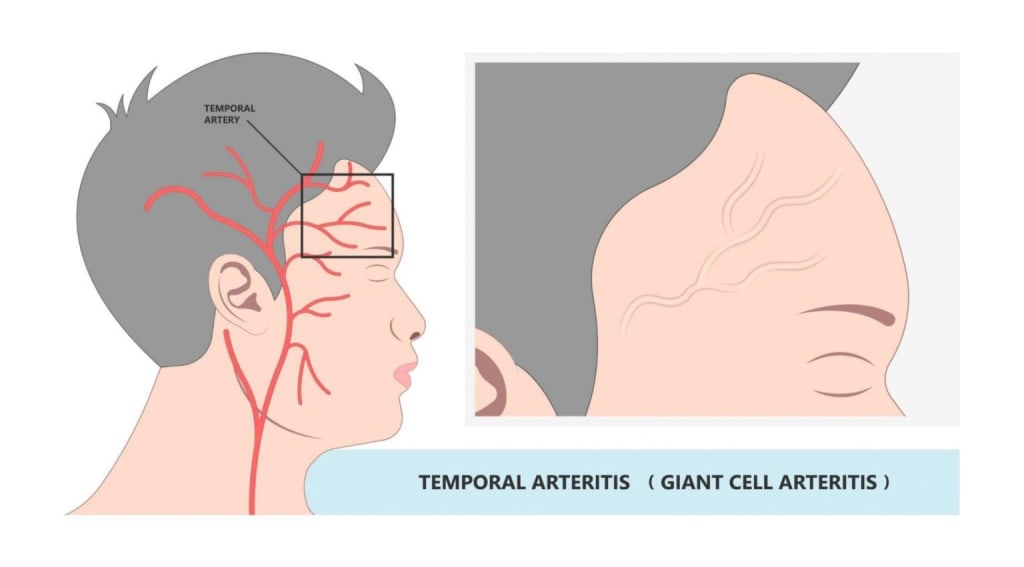Content warning
This story may contain sensitive material or discuss topics that some readers may find distressing. Reader discretion is advised. The views and opinions expressed in this story are those of the author and do not necessarily reflect the official policy or position of Vocal.
TEMPLE HEADACHES
CAUSES, SYMPTOMS & TREATMENT OPTIONS

A headache is considered to be a minor health problem many times. It can be blamed for a long or hectic day or emotional issues. But sometimes the story isn’t that simple! A headache may not be due to a long or tedious day; it can also be an alerting bell of a severe health issue that needs attention. Hence, in case of a prolonged and understood headache, it is advisable to seek professional medical help to tap the root cause and deal with the situation with proper medical care.
A temple headache, also known as a temporal headache, is a type of headache that primarily affects one or both temples, the flat regions on the sides of the forehead. These headaches can vary in intensity and may be caused by various factors, including tension, sinus issues, or underlying medical conditions.
Causes of Temple Headaches
Migraines- Migraines are one of the irritating causes of headaches. It is an issue in which the affected individual feels a pulsating headache on one side of the head. The cause can be annoying if left untreated for a longer time. It is suggested to have meals at a fixed time to lower the symptoms and to avoid food items that trigger the headache.
Temporal Arteritis– It is a medical situation that involves swelling or inflammation of one of the temporal arteries. The problem can be identified by signs such as throbbing headache, pain in the jaw while talking or eating, sensation of tenderness while touching the temples or scalp, and other similar problems. In case of such signs, it is advised to consult for medical help for proper and timely treatment.
Temporal ArteritisTemporal Arteritis
Infection– different diseases damaging the brain, such as viral, bacterial, or fungal infections, can also cause temple headaches. The infection enters the nerves in the brain and may try to disturb its functioning. As a result, the affected individual feels headache, pain in the temples, dizziness, and other similar signs.
Tension- Stress, anxiety, and muscle tension can lead to tension headaches that manifest in the temple area.
Sinusitis- Inflammation or infection of the sinuses can cause temple pain and pressure.
SinusitisSinusitis
Eyestrain- Prolonged screen time or eye strain may lead to temple discomfort.
Dehydration- Lack of proper hydration can trigger headaches, including temple headaches.
Symptoms of Temple Headaches
Tenderness of Temples- It is a symptom of the head pain. The symptoms, if left untreated for a long time, can be accompanied by migraines, dizziness, confusion, irritability, and other similar issues. The affected individual may feel tenderness on one or both temples and scalp tenderness.
Pressurised Temples– One more sign of head pain can be pressure in the temples. It can happen due to migraine, blocked sinus, anxiety, tension, or other mental issues. The pressure may last for a few hours or even can extend for a few days. In case of such signs, it is advised to get the condition checked by a doctor.
Dizziness– One may also feel dizziness in case of temple head pain. It can occur due to a sinus or cognitive issue. One may also experience it due to ear or cervical pain. The patient feels dizzy and cannot concentrate or focus to perform routine functions.
Duration – Temple headaches can last a few minutes to several hours or even days, depending on the type of headache.
Other Symptoms – Depending on the cause, temple headaches may be accompanied by other symptoms such as nausea, vomiting, light sensitivity (photophobia), sound sensitivity (phonophobia), and visual disturbances (in the case of migraines).
Treatment Options to Cure Temple Headaches
OTC Medications- OTC medications, such as NSAIDs, Advil, and Bayer, can help manage headaches. The medications help to lower the headache and its causes. Hence, the affected patient feels relaxed and can perform routine functions with ease.
Stress Management– Stress is one of the significant causes of head pain; hence, managing it efficiently helps to deal with the situation quickly. Practising yoga, exercising, meditation, and other mind-relaxing practices helps lower headaches and manage stress.
Lifestyle Changes– Healthy and positive practices such as avoiding smoking and alcohol, eating timely meals, meditation, and yoga can help to lower stress and other causes of head pain.
Hydration- Dehydration is also one of the reasons behind headaches. Drinking plenty of water can help alleviate symptoms.
Avoiding Triggers- If you identify specific triggers for your headaches (e.g., certain foods, alcohol, caffeine), avoiding them can be helpful.
About the Creator
Enjoyed the story? Support the Creator.
Subscribe for free to receive all their stories in your feed. You could also pledge your support or give them a one-off tip, letting them know you appreciate their work.





Comments
There are no comments for this story
Be the first to respond and start the conversation.